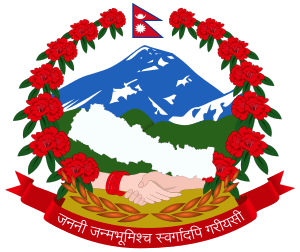Mulkaji
| Mulkaji of Kingdom of Nepal नेपाल अधिराज्यको मूलकाजी | |
|---|---|
 | |
| Style |
Sri Mulkaji Mulkaji Saheb |
| Residence | various |
| Seat | Hanuman Dhoka Palace |
| Appointer | King of Nepal |
| Precursor | Bamsa Raj Pande (as Dewan Kaji of Nepal) |
| Formation | circa 1785 |
| First holder | Abhiman Singh Basnyat |
| Final holder | Ranajit Pande |
| Abolished | 1804 |
| Succession | Rana Bahadur Shah (as Mukhtiyar of Nepal) |
 |
|---|
| This article is part of a series on the politics and government of Nepal |
|
Executive:
Judiciary:
|
|
|
|
Related topics |
Mulkaji (Nepali: मूलकाजी) was the position of head of executive of Kingdom of Nepal in the late 18th and early 19th centuries. It was equivalent to Prime Minister of Nepal. There were 5 Mulkajis appointed between 1785 and 1804.
Meaning
Mulkaji is formed from two words: Mul and Kaji. Mul means Chief, Key or Fundamental[1] and Kaji is derived from Sanskrit word Karyi which meant functionary.[2] Altogether it means Chief Functionary or Executive Head of the State.
History of the five Mulkajis
Abhiman Singh Basnyat
Dewan Kaji Bamsa Raj Pande was beheaded on March 1785 on the conspiracy of Queen Rajendra Laxmi with the help of supporters including senior Kaji Swaroop Singh Karki.[3][4] On 2nd July 1785, Prince Regent Bahadur Shah of Nepal was arrested and on the eleventh day of imprisonment on 13th July, Queen Rajendra Laxmi died.[3][4] Then onwards, Bahadur Shah of Nepal took over the regency of his nephew King Rana Bahadur Shah[5] and the position of Chautariya while Abhiman Singh Basnyat was elected Mulkaji (Chief Kaji).
Kirtiman Singh Basnyat
In 1794, King Rana Bahadur Shah came of age and appointed Kirtiman Singh Basnyat as Chief (Mul) Kaji among the newly appointed four Kajis though Damodar Pande was the most influential Kaji.[6] Kirtiman had succeeded Abhiman Singh Basnyat as Chief Kaji.[7]
Bakhtawar Singh Basnyat
Kirtiman was secretly assassinated on 28 September 1801, by the supporters of Raj Rajeshwari Devi[8] and his brother Bakhtawar Singh Basnyat, was then given the post of Chief (Mul) Kaji.[9]
Damodar Pande
Later Damodar Pande was appointed by Queen Rajrajeshwari as Chief Kaji.[10]
Ranajit Pande
After the execution of Mulkaji Damodar Pande on March 1804, Ranajit Pande was appointed as Mulkaji (Chief Kaji) along with Bhimsen Thapa as second Kaji, Sher Bahadur Shah as Mul Chautariya and Ranganath Paudel as Raj Guru (Royal Preceptor).[11][12]
Later King Rana Bahadur Shah created the title of Mukhtiyar and assume full executive power of the state.[13]
List of Mulkajis of Kingdom of Nepal
| No. | Portrait | Name (Birth–Death) |
Term of Office | Political Party | ||
|---|---|---|---|---|---|---|
| Took Office | Left Office | |||||
| 1 |  |
Abhiman Singh Basnyat (1744–1800) |
1785 | 1794 | Independent | |
| 2 | .jpg) |
Kirtiman Singh Basnyat (??–1801) |
1794 | 28 September, 1801 | Independent | |
| 3 | Bakhtawar Singh Basnyat | 1801 | February 1803 | Independent | ||
| 4 |  |
Damodar Pande (1752–1804) |
February 1803 | March 1804 | Independent | |
| 5 | Ranajit Pande | 1804 | 1804 | Independent | ||
Controversial Mulkaji
Historian Dilli Raman Regmi asserts that Sarbajit Rana Magar was chosen as Chief Kazi.[14] Historian Rishikesh Shah asserts that Sarbajit was appointed only a Kaji [15] and was the head of the Nepalese government for a short period in 1778.[16]
See Also
References
- ↑ "English Translation of "मूल" - Collins Hindi-English Dictionary". www.collinsdictionary.com. Retrieved 31 March 2018.
- ↑ Regmi 1979, p. 43.
- 1 2 Karmacharya 2005, p. 46.
- 1 2 Shaha 2001, p. 62.
- ↑ Pradhan 2012, p. 10.
- ↑ Pradhan 2012, p. 12.
- ↑ Karmacharya 2005, p. 56.
- ↑ Acharya 2012, p. 34.
- ↑ Acharya 2012, p. 35.
- ↑ Pradhan 2012, p. 14.
- ↑ Nepal 2007, p. 58.
- ↑ Acharya 2012, p. 55.
- ↑ Nepal 2007, pp. 60–61.
- ↑ D.R. Regmi 1975, p. 285.
- ↑ Shaha 1990, p. 46.
- ↑ Shaha 2001, p. 21.
Bibliography
- Joshi, Bhuwan Lal; Rose, Leo E. (1966), Democratic Innovations in Nepal: A Case Study of Political Acculturation, University of California Press, p. 551
- Pradhan, Kumar L. (2012), Thapa Politics in Nepal: With Special Reference to Bhim Sen Thapa, 1806–1839, New Delhi: Concept Publishing Company, p. 278, ISBN 9788180698132
- Karmacharya, Ganga (2005), Queens in Nepalese Politics: an account of roles of Nepalese queens in state affairs, 1775-1846, Nepal: Educational Publishing House, ISBN 9789994633937
- Regmi, Mahesh Chandra (1979). "Regmi Research Series". Nepal.
- Shaha, Rishikesh (2001), An introduction to Nepal, Kathmandu: Ratna Pustak Bhandar